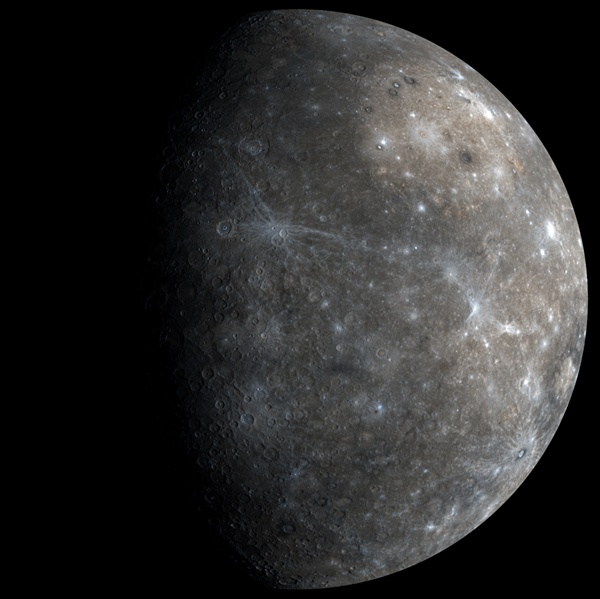The Sky This Week from August 2 to 11 – Astronomy Magazine
Mercury’s morning glory
Although Earthbound observers never see the innermost planet as more than a blur, NASA’s MESSENGER spacecraft revealed it to be a dynamic, crater-pocked world.
NASA/JHUAPL/CIW
With the dog days of summer now in full bloom, it shouldn’t come as any surprise to find the season’s namesake asterism, the Summer Triangle, on prominent display. The trio’s brightest member, Vega in the constellation Lyra the Harp, stands nearly overhead around 11 p.m. local daylight time. The asterism’s second-brightest star, Altair in Aquila the Eagle, then lies nearly two-thirds of the way from the southeastern horizon to the zenith. Deneb, the luminary of Cygnus the Swan, marks the Summer Triangle’s third corner. Although it is this asterism’s dimmest star, it’s the brightest point of light in the northeastern sky.
The Moon reaches perigee, the closest point in its orbit around Earth, at 3:11 a.m. EDT. It then lies 223,320 miles (359,398 kilometers) away from us.
Saturday, August 3
Observers of the outer solar system can get a good view of Uranus before dawn. The best time to look for it is shortly before twilight begins around 4 a.m. local daylight time. Uranus then lies 45° high in the east-southeast against the backdrop of southern Aries the Ram. This morning, use binoculars to find the magnitude 5.8 planet 2.3° south-southeast of the magnitude 5.7 star 19 Arietis. A telescope reveals Uranus’ blue-green disk, which spans 3.6″.
Sunday, August 4
Evenings this week are a great time to explore the constellation Sagittarius the Archer. This star group lies due south and at peak altitude between 10 and 11 p.m. local daylight time, well after the last vestiges of twilight have faded away. The brightest stars within the constellation form the shape of a teapot — a distinctive asterism once you’ve found it. The central regions of the Milky Way pass through Sagittarius, so it’s always worth exploring this area through binoculars or a telescope.
Monday, August 5
This week finds observers caught between the peaks of two nice meteor showers. The Southern Delta Aquariid shower reached maximum the night of July 29/30 and has started to diminish, while the Perseid shower is ramping up in preparation for its peak the morning of August 13. Last week’s New Moon means the morning hours currently remain Moon-free. You can tell meteors from the two showers apart by tracing their paths backward. Southern Delta Aquariid meteors appear to radiate from the constellation Aquarius the Water-bearer while Perseid meteors emanate from Perseus the Hero.
Tuesday, August 6
Magnificent Saturn reached its peak four weeks ago, when it appeared opposite the Sun in the sky, and our view of the ringed planet remains spectacular. It is on display from shortly after sunset until nearly 4 a.m. local daylight time. It currently resides among the background stars of Sagittarius the Archer, hanging in the southeastern sky as darkness falls and climbing highest in the south around 11 p.m. Saturn continues to shine brightly, too, at magnitude 0.2. When viewed through a telescope, the dramatic ring system spans 41″ and tilts 25° to our line of sight, while the planet’s family of modestly bright moons appears next to the gorgeous world.






